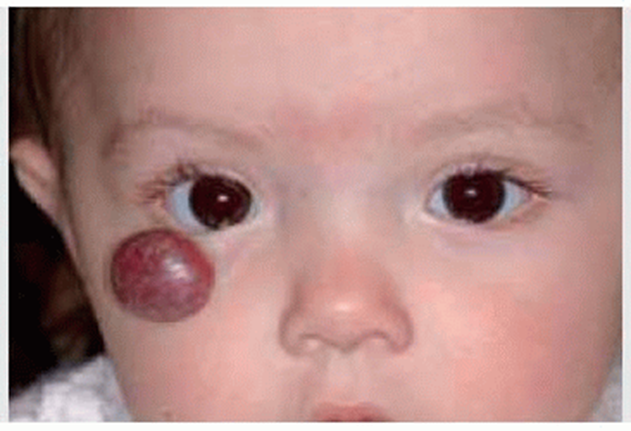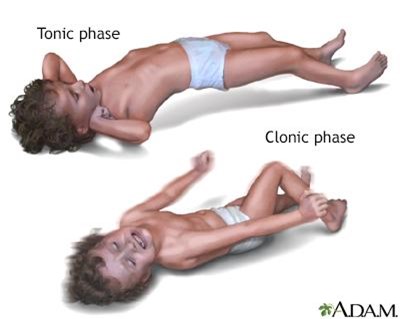A client with a newborn asks about the lesion on her child's head. After assessing the skin, which response will the nurse offer to the client?
This is a vascular tumor that often goes away over time
This lesion will spread
This is caused by scarring from the birth process
This is a precancerous lesion and your child will need a referral to a dermatologist
The Correct Answer is A
Choice A reason: This is correct because the lesion on the child's head is most likely a hemangioma, which is a benign tumor of blood vessels that appears as a red or purple mark on the skin. Hemangiomas are common in newborns and usually grow during the first year of life, then shrink and fade over several years. The nurse should reassure the client that hemangiomas are harmless and do not require treatment unless they interfere with vision, breathing, or feeding.
Choice B reason: This is incorrect because the lesion on the child's head will not spread, but rather grow and shrink within a limited area. The nurse should not alarm the client by suggesting that the lesion will spread to other parts of the body or become malignant. The nurse should explain that hemangiomas are not contagious or infectious and do not affect the child's overall health or development.
Choice C reason: This is incorrect because the lesion on the child's head is not caused by scarring from the birth process, but rather by abnormal growth of blood vessels in the skin. The nurse should not confuse or misinform the client about the cause of the lesion. The nurse should explain that hemangiomas are not related to trauma, infection, or genetics, but rather to unknown factors that influence blood vessel formation during fetal development.
Choice D reason: This is incorrect because the lesion on the child's head is not a precancerous lesion and does not need a referral to a dermatologist. The nurse should not scare or mislead the client by suggesting that the lesion is a sign of cancer or requires further evaluation or treatment. The nurse should explain that hemangiomas are benign and usually resolve on their own without any complications or sequelae.

Nursing Test Bank
Naxlex Comprehensive Predictor Exams
Related Questions
Correct Answer is ["D","E"]
Explanation
Choice A Reason: This choice is incorrect. Placing the client into a supine position is not an action that the nurse should take, as it can compromise the airway and increase the risk of aspiration. The nurse should position the client on their side with their head tilted slightly forward to allow saliva and secretions to drain out of their mouth.
Choice B Reason: This choice is incorrect. Applying restraints is not an action that the nurse should take, as it can cause injury and increase agitation. The nurse should protect the client from harm by removing any objects or furniture that may cause harm and padding any hard surfaces with blankets or pillows.
Choice C Reason: This choice is incorrect. Inserting a bite stick into the client's mouth is not an action that the nurse should take, as it can cause injury and obstruction. The nurse should never force anything into the client's mouth during a seizure, as it can damage their teeth, gums, tongue, or jaw.
Choice D Reason: This is a correct choice. Loosening restrictive clothing is an action that the nurse should take, as it can improve breathing and circulation. The nurse should unbutton any tight collars, belts, or ties that may constrict the chest or neck.
Choice E Reason: This is a correct choice. Placing a pillow under the client's head is an action that the nurse should take, as it can prevent injury and provide comfort. The nurse should support the client's head with a soft pillow or cushion to prevent hitting it against any hard surfaces.

Correct Answer is ["C","E","F"]
Explanation
Choice A reason: This is incorrect because the nurse should not include this in the postoperative education to the client. The client should not drive home after glaucoma surgery, as they will have reduced vision and increased sensitivity to light in the operated eye. The nurse should advise the client to arrange for someone else to drive them home.
Choice B reason: This is incorrect because the nurse should not include this in the postoperative education to the client. The client should not lay on the right side when going to bed, as this can put pressure on the operated eye and increase the risk of bleeding or infection. The nurse should advise the client to sleep on their back or on their left side.
Choice C reason: This is correct because the nurse should include this in the postoperative education to the client. The client should report flashing lights, as this can indicate a complication such as retinal detachment or vitreous hemorrhage. The nurse should instruct the client to call the provider immediately if they see flashing lights.
Choice D reason: This is incorrect because the nurse should not include this in the postoperative education to the client. The client should not nap on their left side when they get home, as this can cause fluid accumulation and increased intraocular pressure in the operated eye. The nurse should advise the client to elevate their head at least 30 degrees when resting.
Choice E reason: This is correct because the nurse should include this in the postoperative education to
the client. The client should avoid housework like vacuuming, as this can cause bending, lifting, or straining that can increase intraocular pressure and affect wound healing. The nurse should advise the client to limit physical activity and follow the provider's instructions on when to resume normal activities.
Choice F reason: This is correct because the nurse should include this in the postoperative education to
the client. The client may see flashes of light in the operated eye, as this is a normal phenomenon caused by stimulation of the retina by gas bubbles or fluid shifts. The nurse should reassure the client that flashes of light are normal and will subside over time.
Whether you are a student looking to ace your exams or a practicing nurse seeking to enhance your expertise , our nursing education contents will empower you with the confidence and competence to make a difference in the lives of patients and become a respected leader in the healthcare field.
Visit Naxlex, invest in your future and unlock endless possibilities with our unparalleled nursing education contents today
Report Wrong Answer on the Current Question
Do you disagree with the answer? If yes, what is your expected answer? Explain.
Kindly be descriptive with the issue you are facing.
